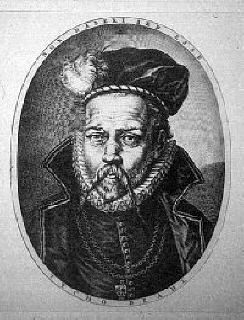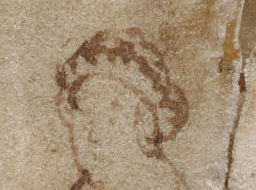|
|
| f116v. Voynich Manuscript. Credit: Beinecke Rare Book and Manuscript Library, Yale University. |
f116v
|
|
| f116v. Voynich Manuscript. Credit: Beinecke Rare Book and Manuscript Library, Yale University. |
Unlike the rest of the manuscript, f116v appears to show a form of writing with Latin alphabet clearly mixed with “Voynich” words, and it has been suggested it may be an attempt at decipherment or even a key to decoding the Voynich alphabet. The image on the folio shown above I suggest may be a summery of the ideology of the manuscript and an acknowledgement of Tycho Brahe as its inspiration.
|
|
|
Image f116v. Voynich Manuscript. Credit: Beinecke Rare Book and Manuscript Library, Yale University. |
|
|
 |
|
False nose covering Tycho’s damaged nose? Voynich Manuscript. Credit: Beinecke Rare Book and Manuscript Library, Yale University. |
Portrait of Tycho showing his metal false nose. Licence PD. Source Wikimedia image. Credit: Sevenfold. |
The strange object at the top that appears to have a hook at the top I suggest is representing the false nose of Tycho Brahe that he wore after losing it in a duel, the holes at the bottom indicating the wound he was left with and the false nose being attached over this. Of all the famous people of history and of astronomers, a false nose is the renowned trademark of Tycho Brahe.
Another image of his nose:
http://curvebank.calstatela.edu/birthdayindex/dec/dec14brahe/brahe2006.jpg
|
|
| Elk/deer? f116v. Voynich Manuscript. Credit: Beinecke Rare Book and Manuscript Library, Yale University. |
The animal figure below the nose has been
suggested to be a lamb or horse among other things, but as it has cloven hooves
it could be a sheep, but not a horse. I suggest the animal represents the
earthly world or microcosm. I suggest the animal may be an elk and in particular
Tycho’s beloved elk that fell down some stairs in a drunken stupor, broke its
leg and died some days later. Tycho's elk was mentioned in a letter between
Brahe and the Landgrave Wilhelm of Kassel dated 1591 ( page 210, Tycho Brahe: A
Picture of Scientific Life and Work in the Sixteenth Century by John L. Dreyer). The creature has clearly split hooves and banding
or spotting on the back reminiscent of a deer, it has a thick or stubby tail, but its overall look and muzzle
and body are more thickly set. It may be an attempt to portray Tycho’s elk
but confusing it with other members of the deer family, rather than as "Alces
alces".
Below the animal is a figure identical to the nymphs found
throughout the manuscript, which I have suggested represent heavenly bodies. It
may show the head of his beloved sister Sophie who was a dutiful assistant and
colleague in his astronomical research. The nymph representing the heavens or
macrocosm.
 |
|
|
Nymph. f116v. Voynich Manuscript. Credit: Beinecke Rare Book and Manuscript Library, Yale University. |
Sophie Brahe from P. Hansens "Illustreret Dansk Litteraturhistorie" bind 1, Anden forøgede udgave 1902. Licence PD. Source: Wikimedia by Saddhiyama. |
The structure in this scenario is therefore Tycho above his elk above a heavenly body, bringing together the earthly (as represented by the elk) and the heavenly (nymph). Over this scene presides Tycho, looking down, suggesting an understanding of the universe and its interconnections as a whole. “As above, so below” sums up Tycho’s approach to the universe, astronomy and alchemy (particularly medicine). His belief in the relationship between the macrocosm and microcosm is shown in these mottoes, “Suspiciendo despicio” (“looking up, I look down”) and Despiciendo suspicio ("looking down, I look up").
|
|
| Fotothek df tg 0005676 Astronomie ^ Vermessung ^ Messinstrument.jpg. Licence CC 3.0. Credit:: Deutsche Fotothek/Wikimedia. Brahe, Tycho, Astronomiae instauratae mechanica, 1598. |
I suggest the Voynich Manuscript is about the study of astronomy both old and new, and the study of medicine as an interdependent whole, rather than separate issues. The question being raised over time as to whether diseases and pestilences were caused by or originated from the heavenly bodies such as comets. If this manuscript were in fact dedicated to Tycho Brahe as suggested, this would explain why Kepler’s new star of 1604, which appeared soon after Tycho’s star, is not part of the subject matter except the occasional possibility of its location being alluded to.
Kepler’s access to and extrapolation of Tycho’s work after his death made Kepler the enemy of Tycho’s family and maybe of Tycho’s loyal friends and other colleagues also. Could the Voynich manuscript be an attempt to show Tycho’s work in its full glory (as astronomer and Paracelsian alchemist) and protect the data from the likes of Kepler? Could Sophie Brahe his beloved sister and fellow astronomer have managed to keep some of Tycho’s work out of Kepler’s hands and passed it on to a confidant (fellow astronomer/doctor?). Could the similarity of Tycho’s star and tales of objects recorded in China brought back to Europe by the Jesuits in manuscripts became apparent and written down in a manuscript, along with other matters of astronomy and medicine from both cultures?
If a comparison between the “guest stars” of China and the “stella nova” of Tycho and Kepler in relation to the star of Bethlehem were included in the subject matter, it could also account for the removal of Capricorn and some of the other lost pages, which could give a clue to where they may now reside if they still exist. The utmost secret coding of the manuscript would protect Tycho’s work from the unscrupulous and a controversial discussion of the star of Bethlehem from the authorities of the time.
Copyright © 2010 P. Han